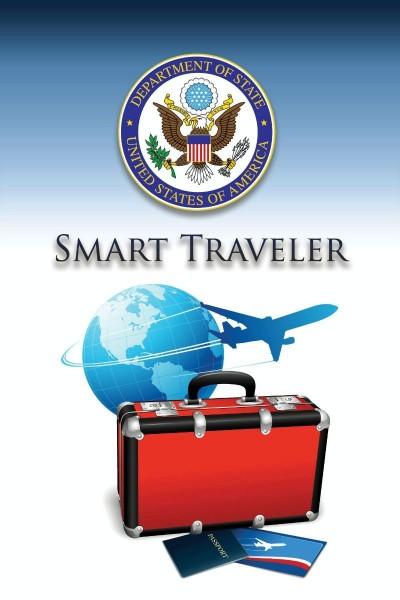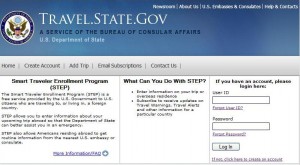Posted Oct. 9, 2012
By LAURIE CHARLES
Before boarding on an eight-hour flight to Spain from Miami for a study abroad trip this summer, George Houck, a junior at the University of Miami, did everything a traveler is supposed to do to ensure he or she has a safe trip.
Houck made photocopies of his passport, left a copy of his itinerary at home, and spoke with other travelers whom had visited Spain to get an idea of what to expect and see while exploring the western European country.

The Department of State’s Smart Traveler Enrollment Program helps travelers to stay safe while abroad (Photo courtesy of U.S. Department of State).
Yet, one thing Houck did, which most travelers are unaware of, was register with the U.S. Department of State’s Smart Traveler Enrollment Program.
STEP is a free service offered to American citizens traveling or living abroad that alerts the U.S. embassy of the country they are visiting of their presence in that specific country.
The program also provides travelers with travel warnings and alerts, health warnings, country specific information and required documentation.
Houck said that he enrolled with STEP because it was highly recommended by the University of Miami’s International Educational Exchange Program, which oversees the university’s study abroad programs.
“It’s for your safety when traveling,” said Pannika, a spokesperson for the U.S. Department of State, who was not allowed to disclose her last name.
“[It] allows the U.S. embassy to know of you traveling to that country and if something happens they can alert your family and friends and better assist you.”
For instance, if a U.S. citizen were to encounter a medical emergency while abroad and notify the nearest embassy or consulate, U.S. consular officers would be able to assist and provide names of local doctors, the Department of State website states.
The Department of State’s website also states that STEP makes it easier for friends and families in the U.S. to contact travelers abroad if they are having trouble contacting them.
Other perks of enrolling in the program are non-emergency assistance when it comes to absentee voting, filing U.S. tax forms, notarizing documents, and issuing passports.
To register with STEP, users are required to create an account with their personal and passport information, as well as an emergency contact in the United States.

Visiting STEP’s homepage is the first step of enrollment (Photo courtesy of U.S. Department of State).
An interesting component of the program is privacy protection; users have the choice of allowing the Department of State to disclose their contact information while abroad to a third party including family members and friends.
This is how the Department of State can contact family in the United States if an incident were to occur abroad.After an account is created, users are ready to register their trip. The enrollment process takes about 20 minutes. Users need to provide about three pages of personal and travel information.
The first page is the itinerary page where travelers select the country they are visiting, the type of visit in terms of an extended or indefinite stay or a frequent or one-time visit, the actual length of stay overseas, as well as contact information while abroad.
Those planning on visiting more than one country can add trips to their itinerary and receive alerts from those countries as well.
“Although I was going to Spain, I signed up for France and Portugal just in case I got a chance to go,” said Houck.
The next page is the traveler’s page where those registering can provide personal and passport information of additional travelers, if any, accompanying them on their journey.
The third page is the travel information distribution page, where users provide an e-mail address that allows the Department of State to communicate with travelers.
Users are then directed to a travel info page, which gives general travel alerts.
Right before completing registration, travelers have the option of choosing to receive emails specific to the embassy or consulate regions selected on their trip.
Once enrolled, travelers are immediately alerted of any issues that may be occurring in their country or countries of visit, such as terrorist attacks, political unrest, health outbreaks, or adverse weather conditions.

The Department of State goes beyond borders to protect U.S. citizens (Photo courtesy of U.S. Department of State.)
Houck said that right after he registered, he received a confirmation e-mail and a link with current up-to-date information about Spain and Andorra
“They [the e-mail] gave a rundown of things that have happened in the past so they basically inform you of past history and current level of threat,” said Houck.
“Past history puts your head into the fact that you are going into a foreign country and bad things have happened in the past and could happen again.”
In addition to keeping him informed, Houck said that STEP helped him make wise travel decisions.
“We [the class] almost took a trip to Morocco but we got an email alert with a specific threat for the weekend we had available to travel, so we didn’t go,” said Houck.
The most recent advancement in STEP was in June 2011 when the Department of State launched the Smart Traveler app for smart phones.
With the app, travelers have access to facts about the country or countries they are visiting, along with travel warnings and alerts at their fingertips.
“The app has everything the website has,” said Pannika. “You pick a country and it tells you everything about that country.”
Travelers can also create their e-Itinerary on the app.
Roger Sierra, a junior at the University of Miami, enrolled with STEP this summer before he embarked on his trip to Poland.
Sierra said it was his first time travelling overseas alone and that he used the app to help him navigate through the land of the Poles.
“I went online and signed up,” said Sierra. “I did it just to please me parents so they wouldn’t worry so much.”
Stephanie Perez-Carrillo, a student at Florida International University, is planning on studying abroad within the next year. She said she had never heard of STEP.
“Now that I know that it exists, I think it would enroll,” said Perez-Carrillo.
“I would want to know what’s going on. I mean how else would you know? If you don’t speak the language [of the country you’re in] it makes it hard to know what’s happening.”
THE STEP PROGRAM
To enroll, visit http://www.step.state.gov.
To purchase the Smart Traveler app for the iPhone or Android, visit http://apps.usa.gov/smart-traveler.shtml.
For more information on how to use the Smart Traveler app, visit http://www.state.gov/r/pa/ei/rls/dos/165020.htm.
